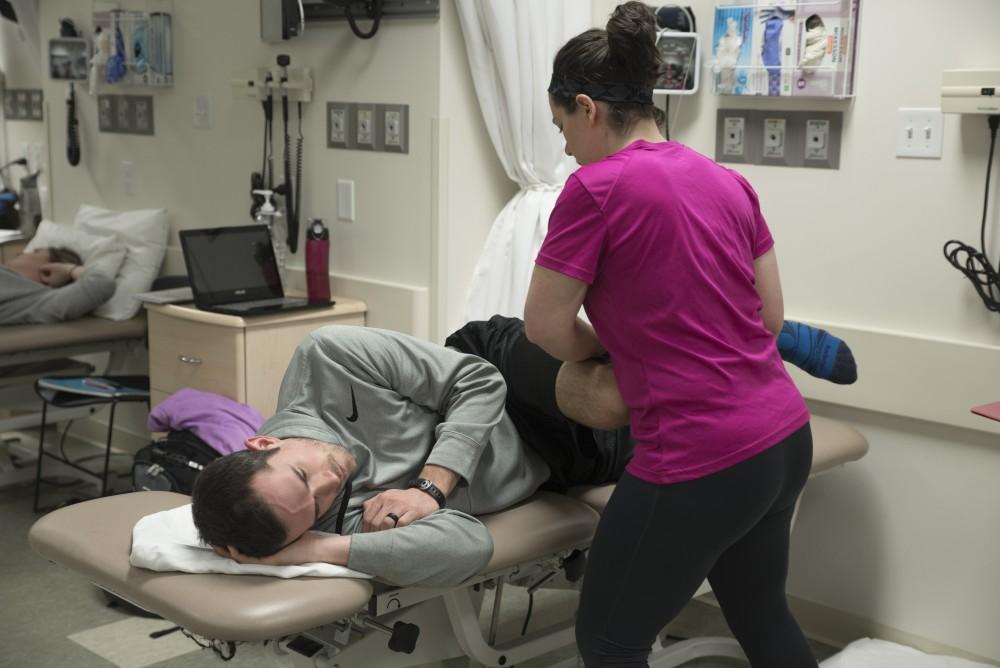Grand Rapids, GVSU create plan for construction of new health campus

GVL / Luke Holmes Melissa Perla helps strectch out Grant Fall in the Physical Therapy room in the Center for Health Sciences Wednesday, Feb. 10, 2016.
Feb 18, 2016
Grand Valley State University is moving forward with the construction of a new health campus on the Grand Rapids Belknap Lookout neighborhood, under a new plan intended to meet the needs of the current residents, the university and the city of Grand Rapids.
Plans for the new health campus began in October of 2013 when GVSU purchased 107 parcels of land located in the Belknap Lookout neighborhood along Interstate 196 for $19 million. Since then, the Neighbors of Belknap Lookout (NOBL), a neighborhood association, have expressed concern for how the university would use the land.
At a meeting on Feb. 12, GVSU’s Board of Trustees approved two memoranda of understanding between the university, City of Grand Rapids and NOBL that clearly outline the construction process.
Eric DeLong, deputy city manager of Grand Rapids, said the Initial Memorandum of Understanding (IMOU) provides details for phase one of development in a way that’s sensitive to the neighborhood.
“The agreement provides for the approval process and how the parties relate to one another,” DeLong said. “It creates a new relationship between the university and the neighborhood.”
In the IMOU, it states that the first phase of construction will involve only Block 2 of GVSU’s Belknap Lookout property. Unless necessary to complete phase one, demolition and other activities are prohibited from taking place on the remainder of the area until a master plan has been completed.
GVSU has also agreed to make an annual payment in lieu of taxes (PILOT) of $127,151 to the City of Grand Rapids, which is purposed with compensating for lost property taxes resulting from the university’s purchase of the Belknap Lookout property.
DeLong said a portion of this payment will go directly toward improving the Belknap Lookout.
“The city’s share is about $25,000 a year,” he said. “The city will invest that $25,000 in the NOBL neighborhood which could go toward a number of things like parks, playground equipment, project planning and the like.”
Under the Memorandum of Understanding-Belknap (MOU-BELKNAP), all three parties agreed on how GVSU will carry out its long-term plan for the Belknap Lookout property.
This long-term plan includes the development of affordable housing located within the northerly 140 feet of Block 2 of the Belknap Lookout property. GVSU will be required to prepare a request for proposal that will draw investors into the neighborhood to develop this affordable housing.
In the event that a family or individual(s) living in the Belknap Lookout is displaced from their home due to construction, the MOU-BELKNAP states they can move into an available GVSU-owned home within the neighborhood.
“If they do this, then GVSU will pay for moving and transfer their security deposit,” DeLong said. “If families wish to move out of the neighborhood, GVSU will reimburse relocation costs up to $2,000 and reimburse their security deposit.”
The MOU-BELKNAP also states that GVSU will place preference on hiring people from the Belknap Lookout neighborhood in construction jobs on the new health campus. Additionally, GVSU will seek out residents of the neighborhood for positions for two years after the facility is completed.
Pat Waring, community relations director at GVSU, said GVSU will work alongside Pastor Jerome Burton of Coit Community Church to help remedy the issue of unemployment in Belknap Lookout.
“The neighborhood, especially Pastor Jerome Burton, is concerned with unemployment among the neighborhood’s young people,” Waring said. “He presently mentors those looking for work. Our plan is to work with Rev. Burton on this issue, of course staying within the law.”
GVSU is now in the planning stages of the health campus construction, though a timeline has yet to be created.
DeLong said the detailed agreement is a huge success story and a model for future collaborations between universities, cities and neighborhoods.
“Together we have found a way to produce a very strong and exciting outcome for the neighborhood,” he said. “That’s a credit to the neighborhood who has worked really hard, but also a credit to GVSU as they were innovative and creative in a way to help us where we need to be.”

























